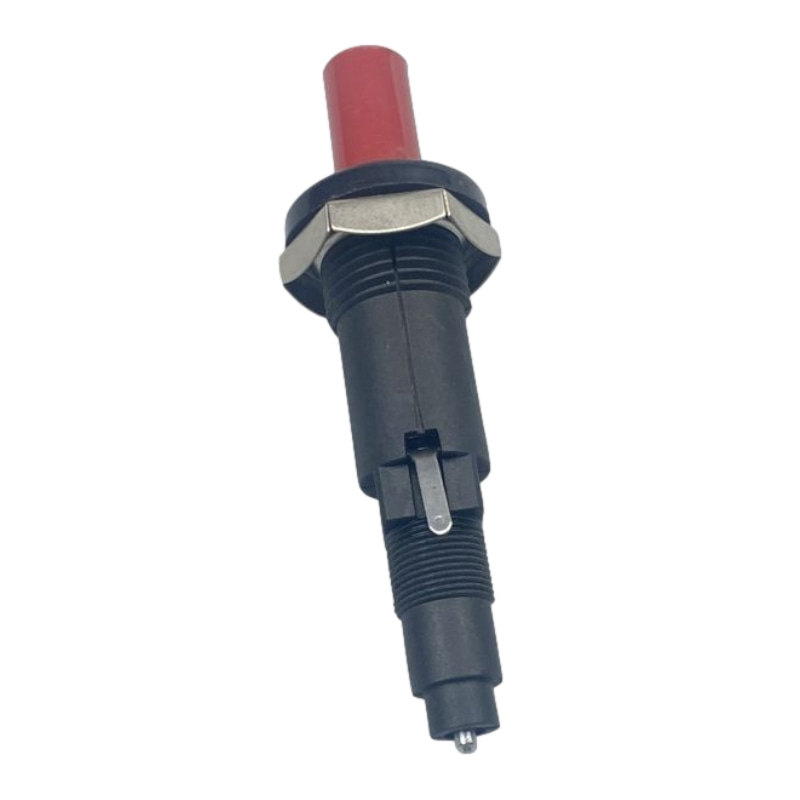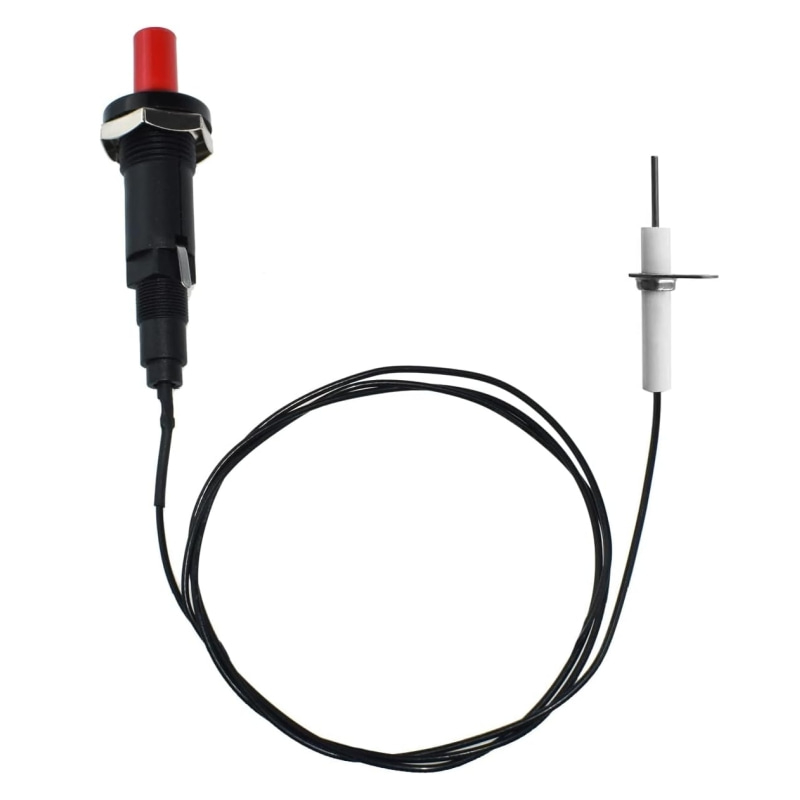







Have you ever wondered how gas appliances ignite effortlessly? A piezo igniter is the key to this modern convenience.
In this article, we’ll explore what a piezo igniter is, its basic functions, and its history. You’ll also learn about its importance in gas appliances and how it outperforms traditional ignition methods.

A piezo igniter is a device used to ignite gas appliances. It generates a spark through mechanical pressure, allowing for quick and reliable ignition. Unlike traditional methods, it doesn’t require batteries or external power sources.
In simple terms, a piezo igniter converts mechanical energy into electrical energy. When you press the igniter, it creates a high-voltage spark that ignites the gas. This spark can reach voltages of 8,000 to 15,000 volts!
The concept of piezoelectricity dates back to the 1880s, discovered by Pierre and Jacques Curie. However, the first practical use in igniters appeared in the mid-20th century. Since then, piezo igniters have evolved, becoming more efficient and widely used in various applications.
Piezo igniters play a crucial role in safety and convenience. They eliminate the need for matches or lighters, reducing fire hazards. Their reliability ensures that appliances ignite quickly, making them ideal for everyday use.
These igniters are found in many common appliances:
● Gas grills: Ensures quick ignition for outdoor cooking.
● Furnaces: Provides reliable heating during cold months.
● Fireplaces: Offers a safe way to start a cozy fire.
Piezo igniters have several advantages compared to traditional methods:
Advantage | Description |
Cost-effective | No need for batteries, reducing long-term costs. |
Low maintenance | Fewer parts mean less wear and tear. |
High reliability | Consistent ignition with minimal failure rates. |
Environmentally friendly | Produces no emissions during operation. |
By using a piezo igniter, you can enjoy the benefits of modern technology while ensuring safety and efficiency in your gas appliances.
At the heart of a piezo igniter is the principle of piezoelectricity. This phenomenon occurs when certain materials generate an electric charge in response to applied mechanical stress. Essentially, when you squeeze or compress these materials, they produce electricity.
The piezoelectric effect is crucial for the igniter's functionality. Materials like quartz and specific ceramics exhibit this effect. When pressure is applied, the internal structure of these materials shifts, creating a voltage. This voltage can be harnessed to generate sparks.
Piezo igniters typically use materials such as:
● Ceramic crystals: These are the most common and efficient materials.
● Quartz: Known for its durability and effectiveness.
● Composite materials: Sometimes used for enhanced performance.
These materials are chosen for their ability to generate high voltages when stressed.
Here's how the ignition process works:
1. Mechanical Stress Application
When you push the igniter button, you apply mechanical stress to the piezoelectric material.
2. Generation of High-Voltage Sparks
This stress causes the material to produce a high-voltage electrical charge. The voltage can reach up to 15,000 volts!
3. Ignition of Gas
The generated spark ignites the gas flowing from the appliance. This quick ignition ensures that your appliance starts efficiently and safely.
Piezo igniters come with several impressive specifications. Understanding these features can help you choose the right igniter for your needs.
One of the standout features is the voltage output. Piezo igniters typically generate between 8,000 to 15,000 volts. This high voltage is essential for creating a strong spark, ensuring reliable ignition every time.
Another important specification is the lifespan. Most piezo igniters can withstand over 50,000 presses! This durability makes them a long-lasting choice for both home and industrial use.
When it comes to size, piezo igniters vary between 3 to 12 cm. This range allows for flexibility in design, ensuring they can fit into various appliances and applications.
There are different types of piezo igniters, each designed for specific uses:
● Manual Models
These require a physical push to ignite. They're simple and effective for many household appliances.
● Automatic Models
These igniters activate automatically when gas is detected. This feature enhances convenience and safety.
Feature | Manual Models | Automatic Models |
Ignition Method | Requires manual pressing | Automatic activation |
Convenience | Less convenient | More user-friendly |
Safety | Depends on user action | Enhanced safety features |
Another distinction is between portable and industrial-grade igniters:
● Portable Igniters
Lightweight and easy to carry, ideal for camping or outdoor cooking.
● Industrial-Grade Igniters
Designed for heavy-duty use in factories or large appliances. They offer higher durability and performance.
Piezo igniters are widely used in various household appliances. Their reliability and efficiency make them a popular choice for ignition systems. Let’s explore some common applications.
One of the most popular uses for piezo igniters is in gas fireplaces. They provide a quick and safe ignition source.
● Example: Model X1
This model features a recessed electrode design, enhancing wind resistance. It ensures a consistent and reliable ignition, even in breezy conditions.
Piezo igniters are also found in ovens and grills. They simplify the process of starting these appliances.
● Example: Model X4
Equipped with ceramic electrode kits, this model offers durability and effective ignition. The ceramic material withstands high temperatures, ensuring longevity.
For outdoor enthusiasts, piezo igniters are essential in portable camping stoves. They make lighting a stove quick and hassle-free.
● Example: Model X5
This model features a push-button design, allowing for easy ignition. Its compact size and lightweight nature make it perfect for camping trips.
Beyond household use, piezo igniters play a significant role in industrial settings.
In commercial environments, piezo igniters are vital for furnaces and heating systems. They ensure efficient and safe ignition in large-scale applications.
● Example: Model X7
This model includes hot surface ignitor kits, designed for high-performance heating systems. They provide reliable ignition in demanding conditions.
When using piezo igniters, it’s important to adhere to safety standards.
● ISO 13943
This standard outlines safety requirements for ignition systems, ensuring they operate safely and effectively. Compliance with such regulations is crucial for manufacturers and users alike.
One of the biggest benefits of piezo igniters is their cost-efficiency. Unlike battery-dependent igniters, piezo igniters don’t require frequent battery replacements. This can lead to significant savings over time.
Feature | Piezo Igniters | Battery-Dependent Igniters |
Cost | Lower long-term costs | Higher due to battery changes |
Maintenance | Minimal | Regular battery replacements |
Environmental Impact | Less waste | More waste from batteries |
Piezo igniters hold a substantial portion of the market. In fact, they account for about 65% of the gas appliance market. This dominance showcases their popularity and effectiveness in various applications.
When it comes to reliability, piezo igniters excel in performance.
● Reduced Clogging
Models featuring recessed electrodes experience 70% less clogging. This design improvement ensures they remain functional longer, even in challenging conditions.
● Consistent Ignition Success Rates
These igniters boast an impressive 99% spark consistency. This means you can count on them for reliable ignition every time you need it.
Another significant advantage is their versatility. Piezo igniters are compatible with a wide range of gas appliances.
● Compatibility with Various Gas Appliances
They work seamlessly with 90% of Weber and Q-series grills. This broad compatibility makes them a go-to choice for many consumers.
● Adaptability to Different Environmental Conditions
Piezo igniters perform well even in low temperatures, such as sub-5°C. This adaptability means they can be used in various climates without compromising performance.
When it comes to ignition systems, piezo igniters stand out among various options. Let’s compare them with traditional ignition methods, hot-surface igniters, and electric spark igniters.
Traditional methods often involve matches or pilot lights. While these methods are simple, they have limitations.
● Pros:
○ Easy to use
○ Low initial cost
● Cons:
○ Risk of accidents
○ Less reliable in windy or wet conditions
Hot-surface igniters use an electrically heated element to ignite gas. They are common in modern appliances.
● Pros:
○ Reliable ignition
○ Good for high-efficiency systems
● Cons:
○ Higher energy consumption
○ More delicate and prone to damage
Electric spark igniters create a spark to ignite gas. They are widely used in various applications.
● Pros:
○ Fast ignition
○ Consistent performance
● Cons:
○ Dependent on electricity
○ Can fail if not maintained properly
Ignition System | Pros | Cons |
Piezo Igniter | Cost-effective, low maintenance | Requires manual activation |
Traditional Methods | Simple, low cost | Safety risks, unreliable in bad weather |
Hot-Surface Igniters | Reliable, efficient | High energy use, fragile |
Electric Spark Igniters | Quick ignition, consistent | Electricity-dependent, requires upkeep |
● Piezo Igniters: Low energy use, as they operate mechanically.
● Hot-Surface Igniters: Consume more energy due to heating elements.
● Electric Spark Igniters: Require a continuous power source, impacting energy costs.
● Piezo Igniters: Minimal maintenance needed; check for wear occasionally.
● Traditional Methods: No maintenance, but safety checks are essential.
● Hot-Surface Igniters: Regular inspections needed to prevent failure.
● Electric Spark Igniters: Require periodic checks to ensure proper function.
● Piezo Igniters: Perform well in various conditions, including cold weather.
● Traditional Methods: Reliability decreases in windy or wet environments.
● Hot-Surface Igniters: Generally perform well but can fail in extreme cold.
● Electric Spark Igniters: Effective but may struggle without power.

Piezo igniters are evolving rapidly, thanks to innovative technologies. Let’s explore some of the recent advancements and future trends shaping this field.
Recent improvements in piezo ignition technology have focused on enhancing performance and durability. These innovations aim to make igniters more efficient and user-friendly.
One of the most exciting developments is the introduction of nanoceramic materials. These upgrades have several advantages:
● Increased Lifespan: They can double the lifespan of piezo igniters, allowing for up to 200,000 presses. This means fewer replacements and lower costs over time.
● Enhanced Durability: Nanoceramics are more resistant to wear and tear, making them ideal for high-use applications.
Another area of innovation involves load optimization techniques.
● Patented Resistor Tuning: This technology helps balance the load on the igniter, improving efficiency. By fine-tuning the electrical resistance, manufacturers can enhance performance and reduce energy consumption.
Looking ahead, several trends are emerging in piezo ignition technology.
● Smart Features: Future piezo igniters may integrate seamlessly with smart home systems. This could allow users to control their appliances remotely, enhancing convenience.
● Charging IoT Sensors: There’s significant potential for piezo igniters to power Internet of Things (IoT) sensors. By harnessing energy from igniter activation, these devices could charge themselves, reducing the need for batteries.
A: A piezo igniter typically lasts around 20,000 to 30,000 presses, but advancements can extend this to 200,000 presses.
A: Piezo igniters are generally not repairable; replacement is usually necessary when they fail.
A: Check for dirt or debris, ensure proper connection, and test the button mechanism for functionality.
A: Yes, piezo igniters are safe when used according to manufacturer instructions.
A: Minimal maintenance is needed; regular cleaning and inspection are sufficient.
A: They perform reliably in windy conditions, as they do not rely on flames.
A: Piezo igniters are energy-efficient and reduce reliance on batteries or electrical power.
Piezo igniters play a crucial role in modern appliances. They are reliable, safe, and energy-efficient.
When choosing an igniter, consider your specific needs and usage.
Explore our range of piezo igniters to find the perfect match for your appliances!